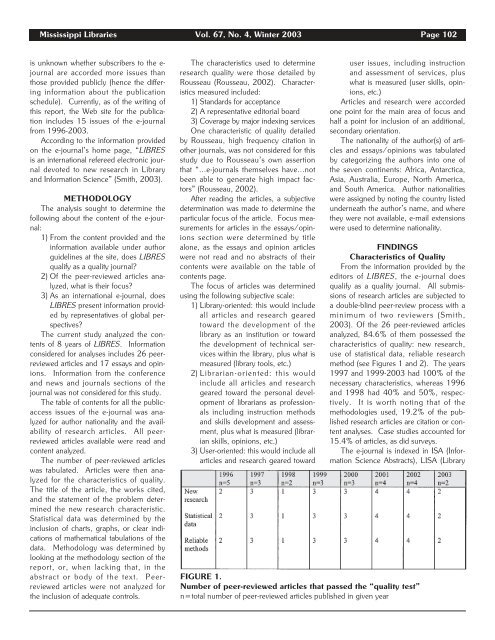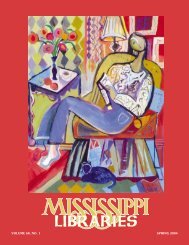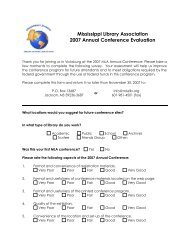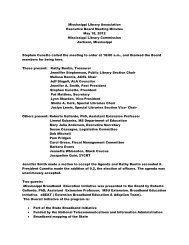Full Text (PDF) - Mississippi Library Association
Full Text (PDF) - Mississippi Library Association
Full Text (PDF) - Mississippi Library Association
You also want an ePaper? Increase the reach of your titles
YUMPU automatically turns print PDFs into web optimized ePapers that Google loves.
<strong>Mississippi</strong> Libraries Vol. 67, No. 4, Winter 2003 Page 102<br />
is unknown whether subscribers to the e-<br />
journal are accorded more issues than<br />
those provided publicly (hence the differing<br />
information about the publication<br />
schedule). Currently, as of the writing of<br />
this report, the Web site for the publication<br />
includes 15 issues of the e-journal<br />
from 1996-2003.<br />
According to the information provided<br />
on the e-journal’s home page, “LIBRES<br />
is an international refereed electronic journal<br />
devoted to new research in <strong>Library</strong><br />
and Information Science” (Smith, 2003).<br />
METHODOLOGY<br />
The analysis sought to determine the<br />
following about the content of the e-journal:<br />
1) From the content provided and the<br />
information available under author<br />
guidelines at the site, does LIBRES<br />
qualify as a quality journal<br />
2) Of the peer-reviewed articles analyzed,<br />
what is their focus<br />
3) As an international e-journal, does<br />
LIBRES present information provided<br />
by representatives of global perspectives<br />
The current study analyzed the contents<br />
of 8 years of LIBRES. Information<br />
considered for analyses includes 26 peerreviewed<br />
articles and 17 essays and opinions.<br />
Information from the conference<br />
and news and journals sections of the<br />
journal was not considered for this study.<br />
The table of contents for all the publicaccess<br />
issues of the e-journal was analyzed<br />
for author nationality and the availability<br />
of research articles. All peerreviewed<br />
articles available were read and<br />
content analyzed.<br />
The number of peer-reviewed articles<br />
was tabulated. Articles were then analyzed<br />
for the characteristics of quality.<br />
The title of the article, the works cited,<br />
and the statement of the problem determined<br />
the new research characteristic.<br />
Statistical data was determined by the<br />
inclusion of charts, graphs, or clear indications<br />
of mathematical tabulations of the<br />
data. Methodology was determined by<br />
looking at the methodology section of the<br />
report, or, when lacking that, in the<br />
abstract or body of the text. Peerreviewed<br />
articles were not analyzed for<br />
the inclusion of adequate controls.<br />
The characteristics used to determine<br />
research quality were those detailed by<br />
Rousseau (Rousseau, 2002). Characteristics<br />
measured included:<br />
1) Standards for acceptance<br />
2) A representative editorial board<br />
3) Coverage by major indexing services<br />
One characteristic of quality detailed<br />
by Rousseau, high frequency citation in<br />
other journals, was not considered for this<br />
study due to Rousseau’s own assertion<br />
that “…e-journals themselves have…not<br />
been able to generate high impact factors”<br />
(Rousseau, 2002).<br />
After reading the articles, a subjective<br />
determination was made to determine the<br />
particular focus of the article. Focus measurements<br />
for articles in the essays/opinions<br />
section were determined by title<br />
alone, as the essays and opinion articles<br />
were not read and no abstracts of their<br />
contents were available on the table of<br />
contents page.<br />
The focus of articles was determined<br />
using the following subjective scale:<br />
1) <strong>Library</strong>-oriented: this would include<br />
all articles and research geared<br />
toward the development of the<br />
library as an institution or toward<br />
the development of technical services<br />
within the library, plus what is<br />
measured (library tools, etc.)<br />
2) Librarian-oriented: this would<br />
include all articles and research<br />
geared toward the personal development<br />
of librarians as professionals<br />
including instruction methods<br />
and skills development and assessment,<br />
plus what is measured (librarian<br />
skills, opinions, etc.)<br />
3) User-oriented: this would include all<br />
articles and research geared toward<br />
user issues, including instruction<br />
and assessment of services, plus<br />
what is measured (user skills, opinions,<br />
etc.)<br />
Articles and research were accorded<br />
one point for the main area of focus and<br />
half a point for inclusion of an additional,<br />
secondary orientation.<br />
The nationality of the author(s) of articles<br />
and essays/opinions was tabulated<br />
by categorizing the authors into one of<br />
the seven continents: Africa, Antarctica,<br />
Asia, Australia, Europe, North America,<br />
and South America. Author nationalities<br />
were assigned by noting the country listed<br />
underneath the author’s name, and where<br />
they were not available, e-mail extensions<br />
were used to determine nationality.<br />
FINDINGS<br />
Characteristics of Quality<br />
From the information provided by the<br />
editors of LIBRES, the e-journal does<br />
qualify as a quality journal. All submissions<br />
of research articles are subjected to<br />
a double-blind peer-review process with a<br />
minimum of two reviewers (Smith,<br />
2003). Of the 26 peer-reviewed articles<br />
analyzed, 84.6% of them possessed the<br />
characteristics of quality: new research,<br />
use of statistical data, reliable research<br />
method (see Figures 1 and 2). The years<br />
1997 and 1999-2003 had 100% of the<br />
necessary characteristics, whereas 1996<br />
and 1998 had 40% and 50%, respectively.<br />
It is worth noting that of the<br />
methodologies used, 19.2% of the published<br />
research articles are citation or content<br />
analyses. Case studies accounted for<br />
15.4% of articles, as did surveys.<br />
The e-journal is indexed in ISA (Information<br />
Science Abstracts), LISA (<strong>Library</strong><br />
FIGURE 1.<br />
Number of peer-reviewed articles that passed the “quality test”<br />
n=total number of peer-reviewed articles published in given year














